MERCEDES-BENZ METRIS 2016 MY16 Operator’s Manual
Manufacturer: MERCEDES-BENZ, Model Year: 2016, Model line: METRIS, Model: MERCEDES-BENZ METRIS 2016Pages: 310, PDF Size: 7.28 MB
Page 41 of 310
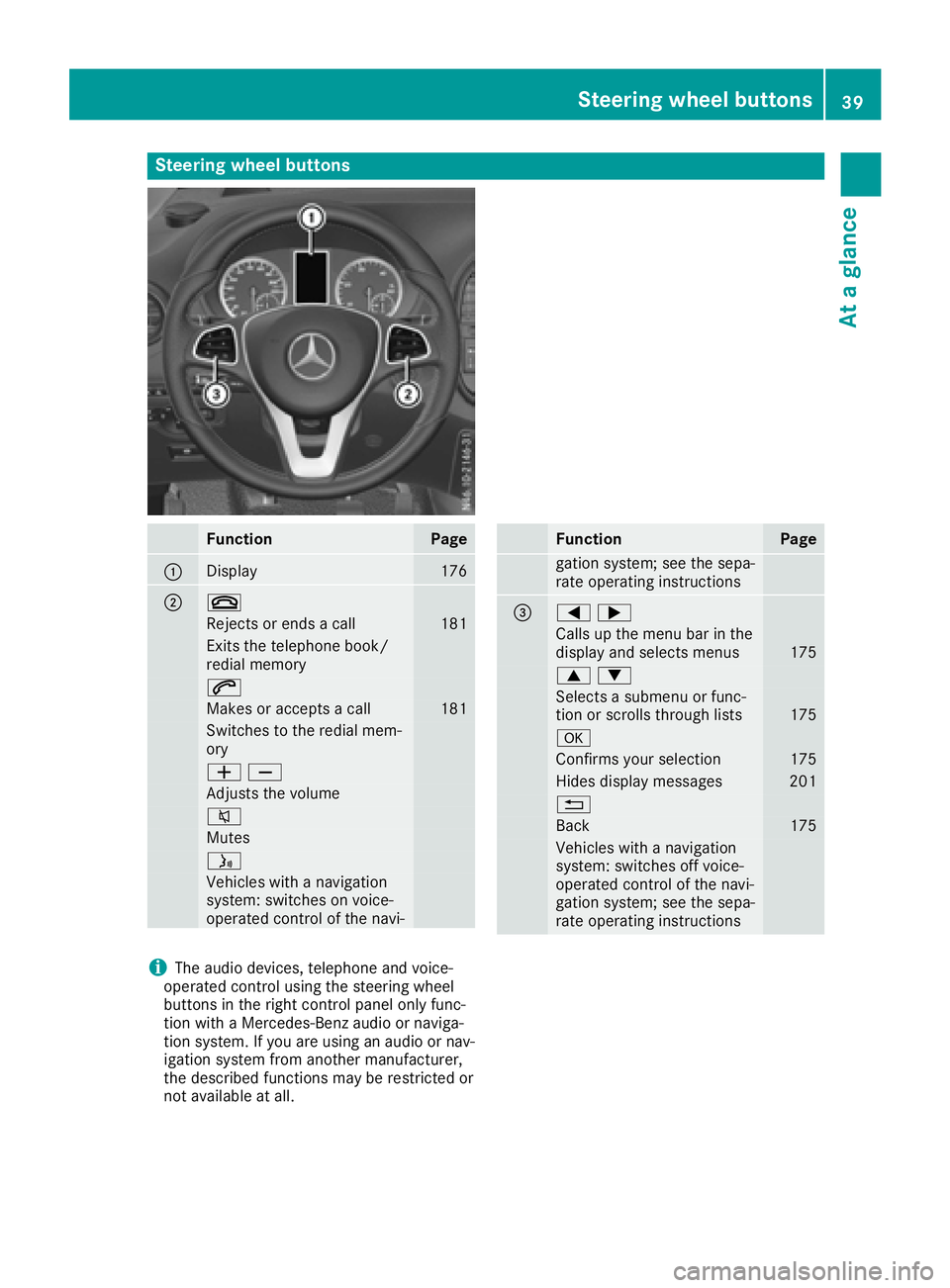
Steering wheel buttons
FunctionPage
:Display176
;~
Rejects or endsacall181
Exitst he telephone book/
redial memory
6
Makes or accepts acall181
Switches to the redial mem-
ory
WX
Adjusts the volume
8
Mutes
ó
Vehicles with anavigation
system :switches on voice-
operated contro lofthe navi-
FunctionPage
gatio nsystem ;see the sepa-
rate operating instructions
==;
Calls up th emenub arinthe
display and select smenus175
9:
Selects asubmenu or func-
tion or scrolls through lists175
a
Confirm syours election175
Hides display messages201
%
Back175
Vehicles with anavigation
system: switches off voice-
operate dcontrol of the navi-
gation system; see the sepa-
rate operating instructions
iThe audi odevices, telephone and voice-
operate dcontrol using the steering wheel
buttons in the right control panel only func-
tion with aMercedes-Benz audi oornaviga-
tion system. If yo uare using an audi oornav-
igation system from another manufacturer,
the described functions may be restricted or
not available at all.
Steering whee lbuttons39
At ag lance
Page 42 of 310
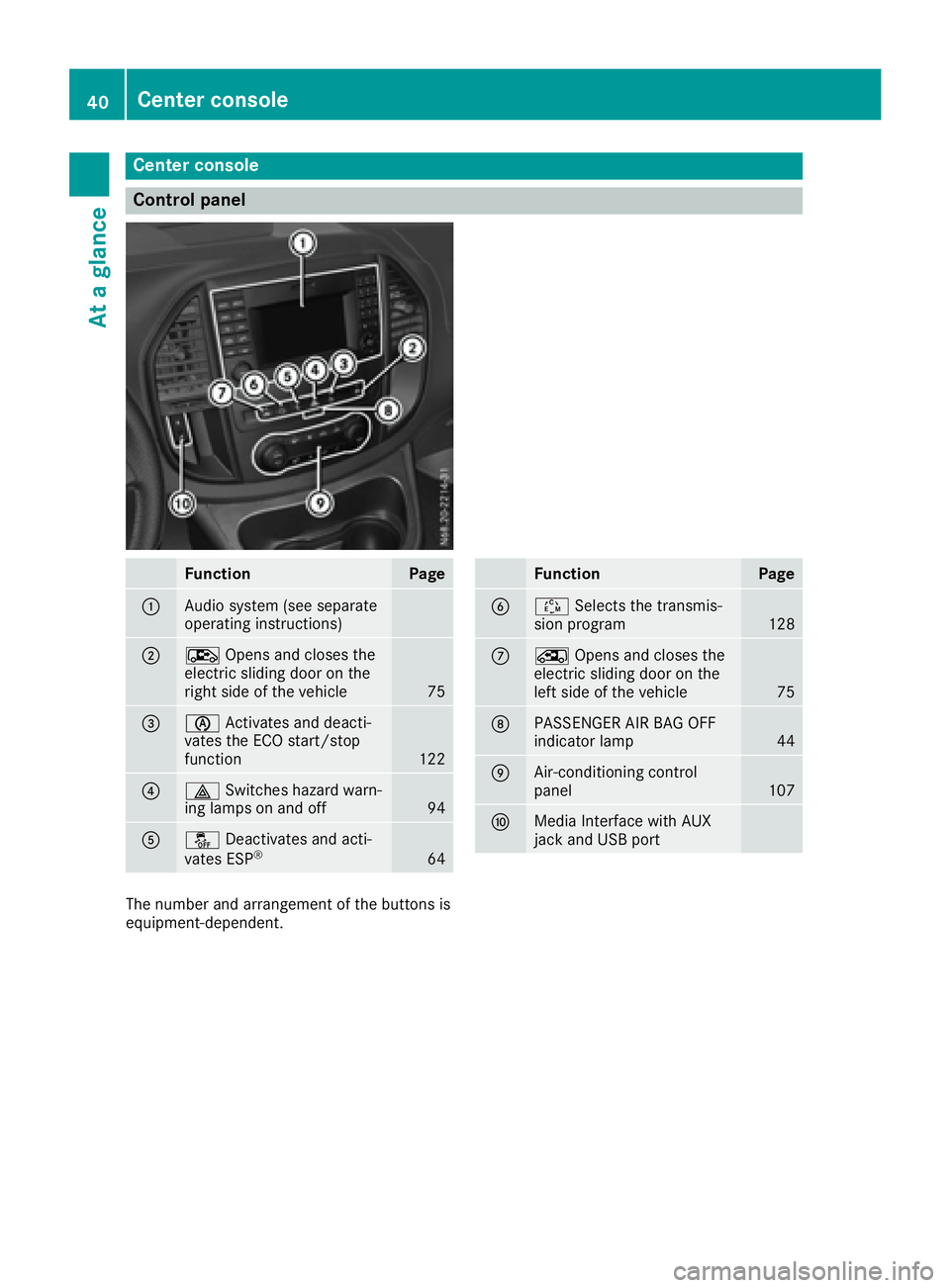
Center console
Control panel
FunctionPage
:Audiosystem (see separate
operatin ginstructions)
;Æ Opensa nd closes the
electric slidingd oor on the
righ tside of th evehicle
75
=è Activate sand deacti-
vates th eECO start/stop
function
122
?£ Switches hazard warn-
ing lamps on and off94
Aå Deactivates and acti-
vates ESP®64
FunctionPage
BÉ Select sthe transmis-
sion program128
CÅ Opensa nd closes the
electric slidingd oor on the
left side of th evehicle
75
DPASSENGER AI RBAG OFF
indicator lamp44
EAir-conditioning control
panel107
FMedia Interface withA UX
jac ka nd USBp ort
The number and arrangement of th ebuttons is
equipment-dependent.
40Center console
At ag lance
Page 43 of 310
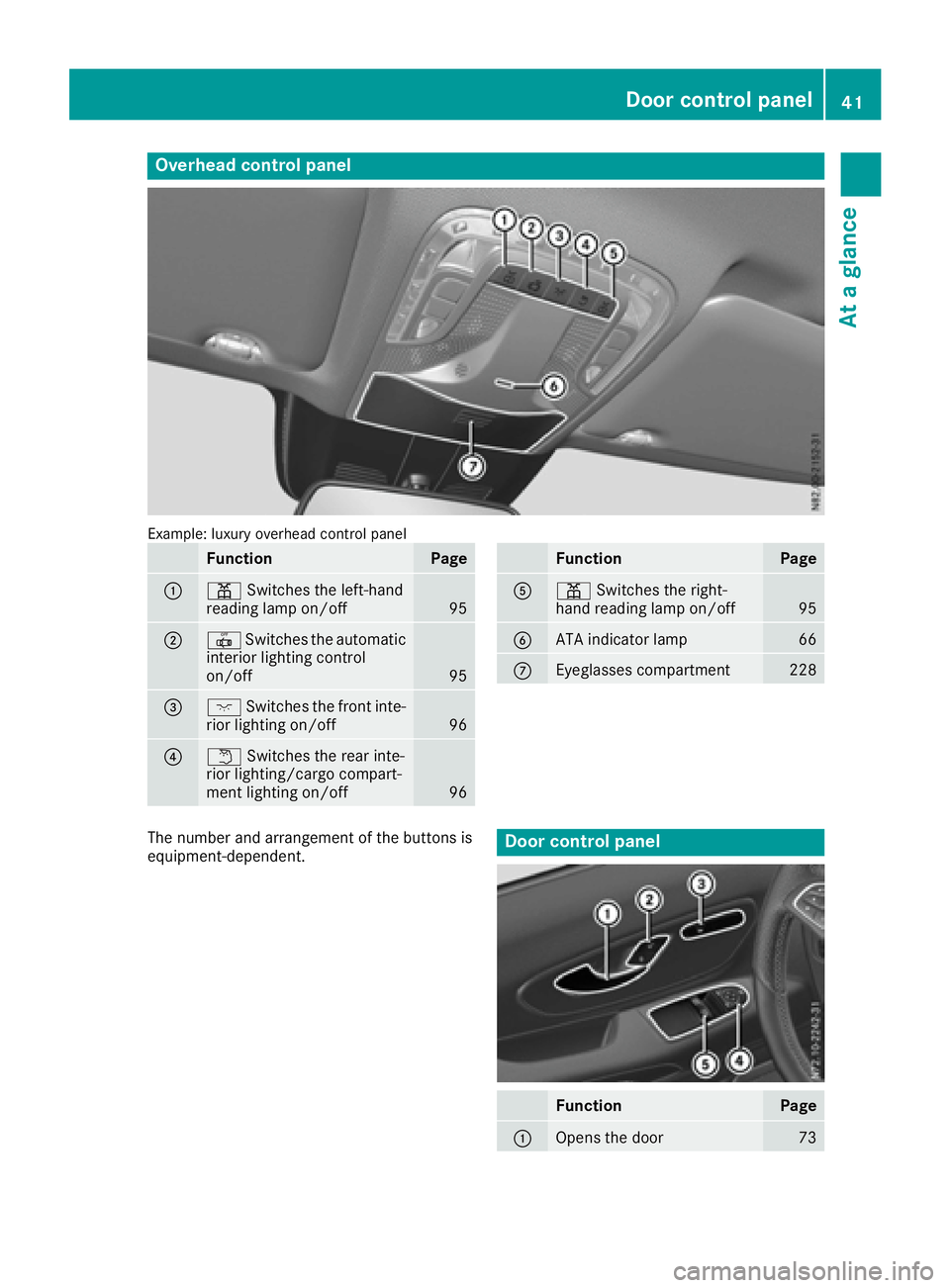
Overheadcontrol panel
Example: luxury overhead control panel
FunctionPage
:p Switches the left-hand
reading lamp on/off95
;| Switches the automatic
interior lighting control
on/off
95
=c Switches the fronti nte-
rior lighting on/off96
?w Switches the rear inte-
rior lighting/cargo compart-
ment lighting on/off
96
FunctionPage
Ap Switches the right-
hand reading lamp on/off95
BATA indicator lamp66
CEyeglasses compartment228
The number and arrangemen tofthe button sis
equipment-dependent.Door control panel
FunctionPage
:Opens the door73
Door control panel41
At ag lance
Page 44 of 310
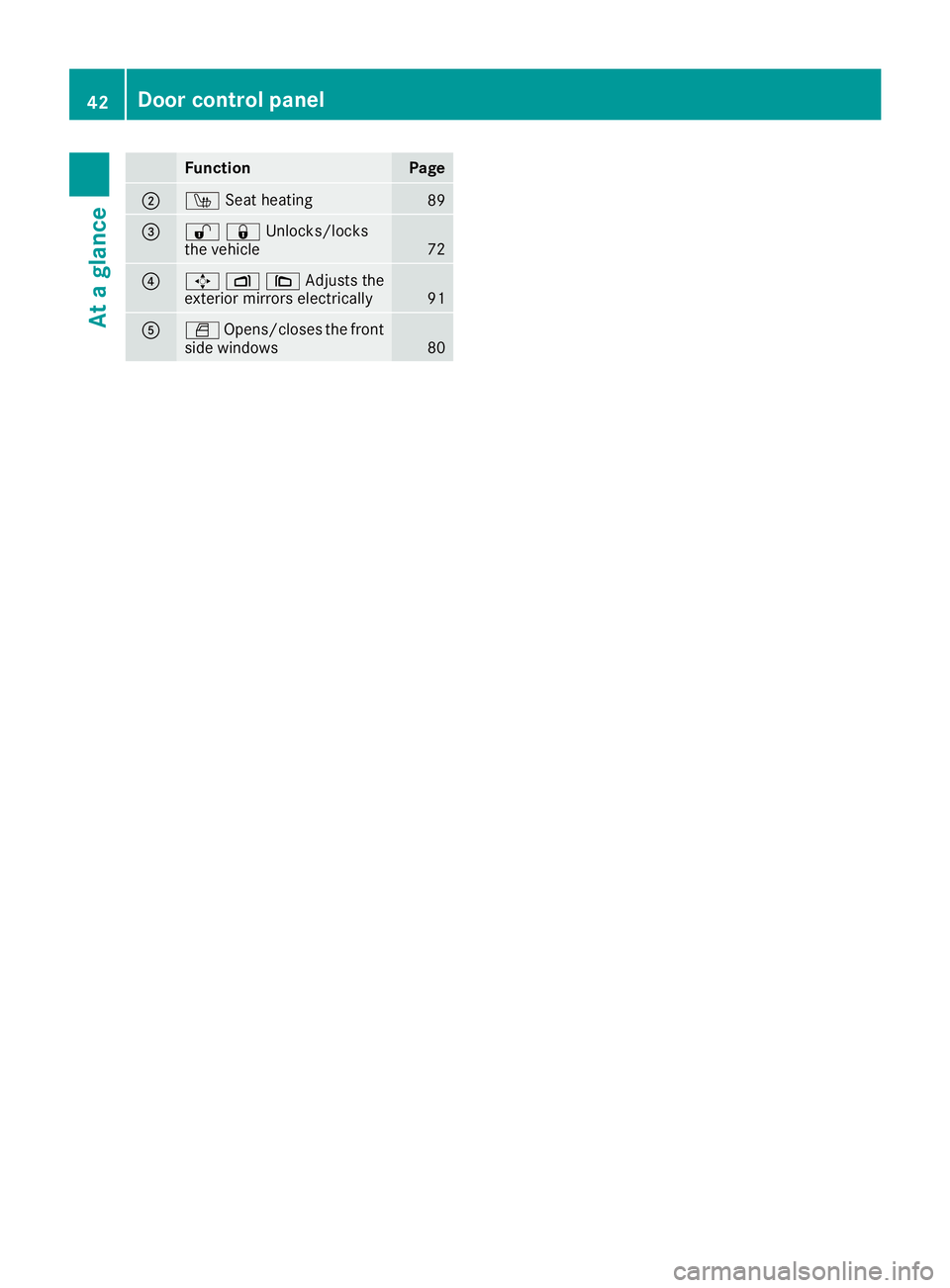
FunctionPage
;ÍSeat heating89
=%&Unlocks/locks
the vehicle72
?7Z\Adjusts the
exterio rmirrors electrically91
AW Opens/close sthe front
side windows80
42Door controlp anel
Atag lance
Page 45 of 310
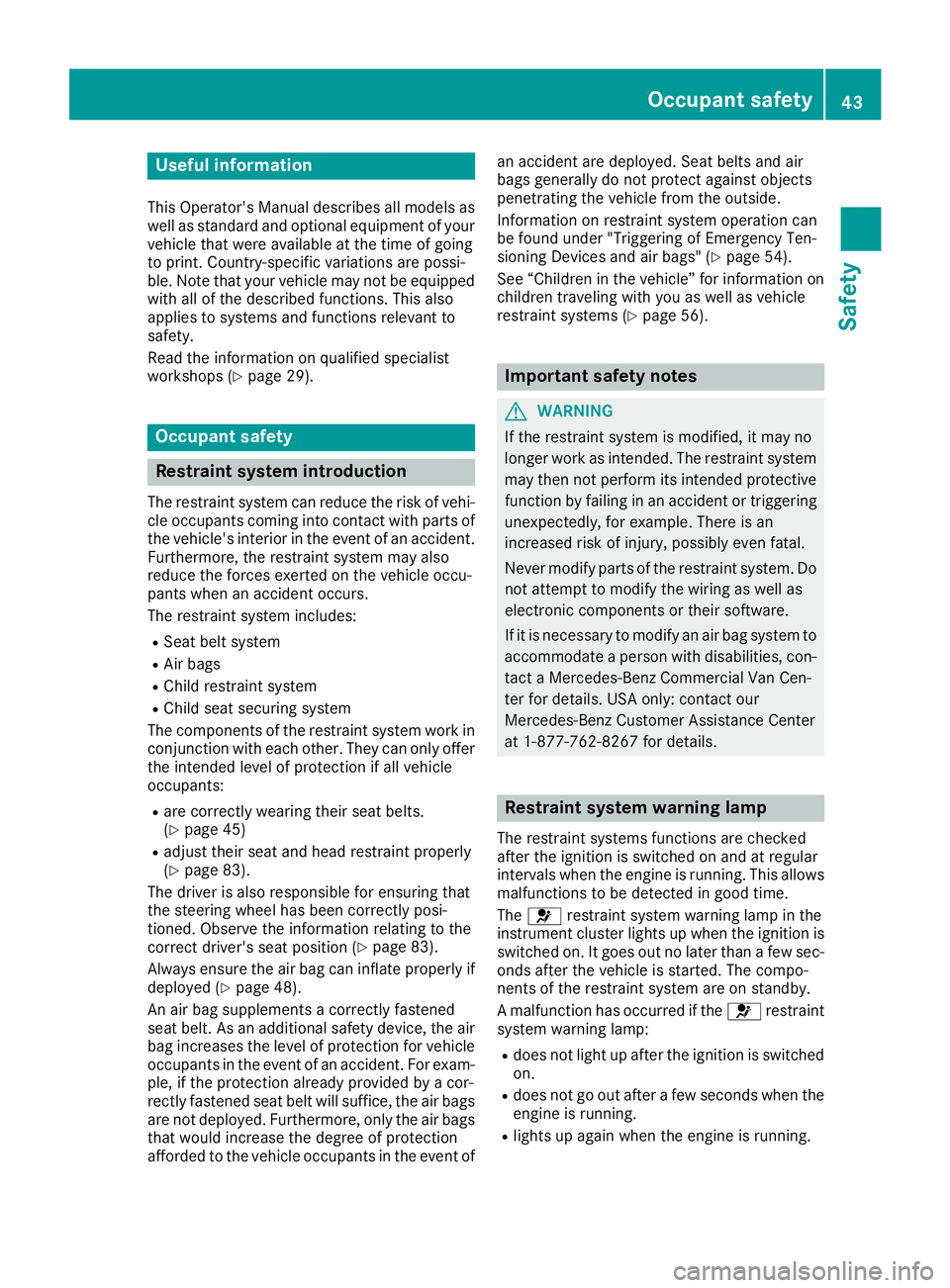
Useful information
This Operator's Manual describes all models as
well as standard and optional equipment of your
vehicle that were available at the time of going
to print.Country-specific variation sare possi-
ble. Note that your vehicle may not be equipped
with all of the described functions. This also
applies to system sand function srelevantt o
safety.
Read the information on qualified specialist
workshops (
Ypage 29).
Occupant safety
Restraint system introduction
The restraint system can reduce the risk of vehi- cle occupants comingi ntoc ontact with parts of
the vehicle' sinterior in the eventofana ccident.
Furthermore, the restraint system may also
reduce the forces exerted on the vehicle occu-
pant swhen an acciden toccurs.
The restraint system includes:
RSeat belt system
RAir bags
RChild restraint system
RChild seat securings ystem
The components of the restraint system work in
conjunction with each other .They can only offer
the intended level of protection if all vehicle
occupants:
Rare correctly wearing their seat belts.
(Ypage 45)
Radjust their seat and head restraint properly
(Ypage 83).
The driver is also responsible for ensurin gthat
the steering wheel has been correctly posi-
tioned. Observet he information relatin gtothe
correct driver'ss eat position (
Ypage 83).
Always ensure the air bag can inflat eproperly if
deployed (
Ypage 48).
An air bag supplement sacorrectly fastened
seat belt. As an additional safetyd evice, the air
bag increases the level of protection for vehicle
occupants in the eventofana ccident. For exam-
ple, if the protection already provided by acor-
rectly fastened seat belt will suffice, the air bags
are not deployed. Furthermore, only the air bags
that would increase the degree of protection
afforded to the vehicle occupants in the evento fan acciden
tare deployed. Seat belts and air
bags generally do not protect against objects
penetratin gthe vehicle from the outside.
Information on restraint system operatio ncan
be found under "TriggeringofE mergencyTen-
sionin gDevices and air bags" (
Ypage 54).
See “Children in the vehicle” for information on children traveling with you as well as vehicle
restraint system s(
Ypage 56).
Important safetyn otes
GWARNING
If the restraint system is modified, it may no
longer work as intended. The restraint system
may then not performi ts intended protective
function by failing in an acciden tortriggering
unexpectedly, for example. There is an
increased risk of injury, possibly even fatal.
Never modify parts of the restraint system .Do
not attempt to modify the wiring as well as
electronic components or their software.
If it is necessary to modify an air bag system to
accommodate aperson with disabilities, con-
tact aMercedes-Benz Commercial Van Cen-
ter for details. USA only: contact our
Mercedes-Benz Customer Assistance Center
at 1-877-762-8267 for details.
Restraint system warning lamp
The restraint system sfunction sare checked
after the ignition is switched on and at regular
intervals when the engin eisrunning. This allows
malfunction stobedetected in good time.
The 6 restraint system warnin glamp in the
instrumentc luster lights up when the ignition is
switched on. It goes out no later than afew sec-
onds after the vehicle is started. The compo-
nents of the restraint system are on standby.
Am alfunction has occurred if the 6restraint
system warnin glamp:
Rdoes not light up after the ignition is switched
on.
Rdoes not go out after afew seconds when the
engin eisrunning.
Rlights up again when the engin eisrunning.
Occupant safety43
Safety
Z
Page 46 of 310
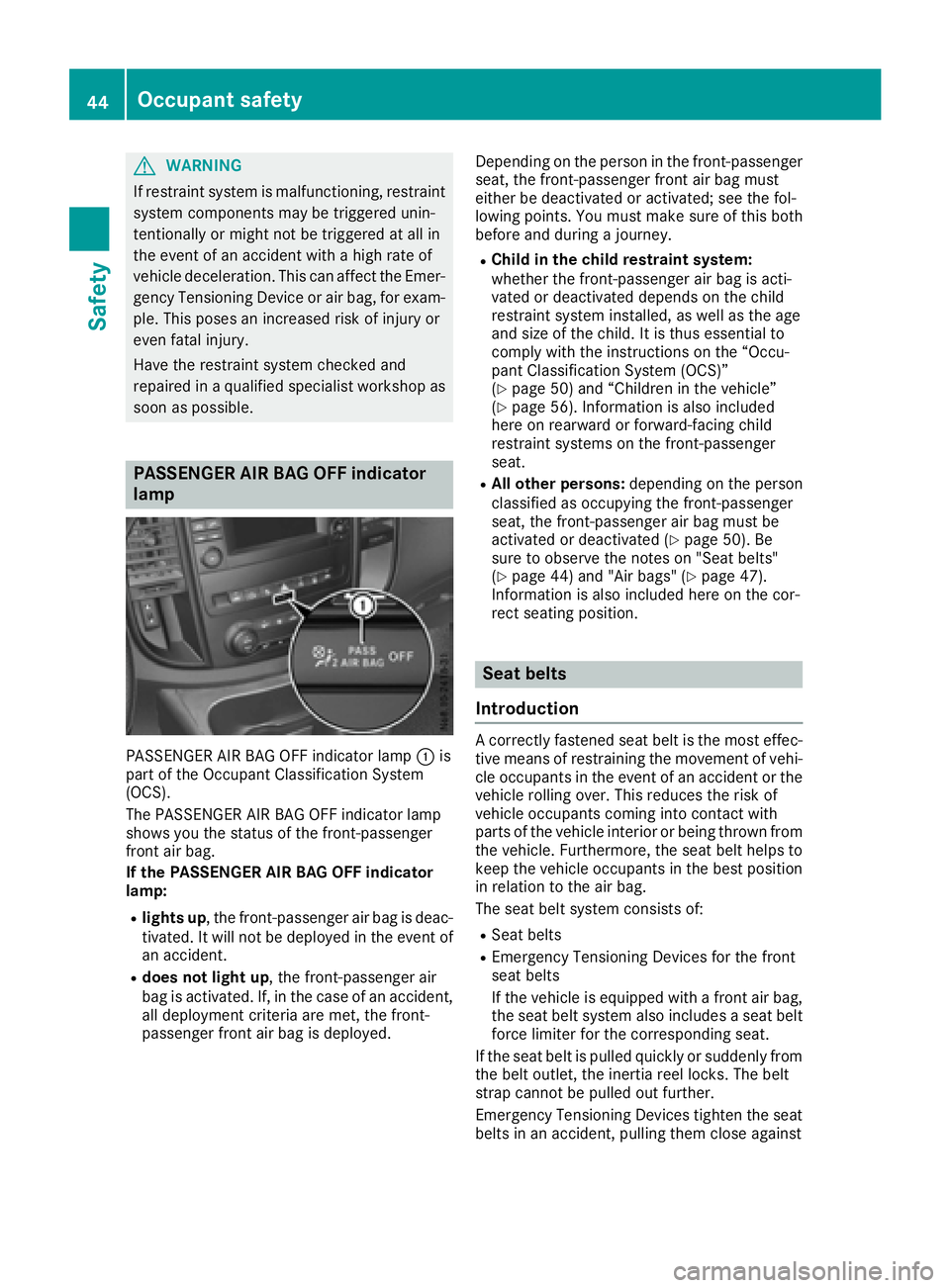
GWARNING
If restraint system is malfunctioning, restraint
system components may be triggere dunin-
tentionall yormight not be triggere datall in
the event of an accident with ahigh rate of
vehicled eceleration. This can affect the Emer-
gency Tensioning Device or air bag ,for exam-
ple.T his poses an increased risk of injury or
even fatal injury.
Have the restraint system checked and
repaired in aqualified specialist worksho pas
soon as possible.
PASSENGER AI RBAG OFF indicator
lamp
PASSENGER AIR BAG OFF indicator lamp :is
part of the Occupant Classification System
(OCS).
The PASSENGER AIR BAG OFF indicator lamp
showsy ou the status of the front-passenger
front air bag.
If the PASSENGER AI RBAG OFF indicator
lamp:
Rlights up,t he front-passenge rair bag is deac-
tivated. It wil lnot be deploye dinthe event of
an accident.
Rdoes not light up,t he front-passengerair
bag is activated. If, in the case of an accident,
all deployment criteria are met, the front-
passenger front air bag is deployed. Depending on the personint
he front-passenger
seat, the front-passenge rfront air bag must
either be deactivated or activated; see the fol-
lowing points. You must make sure of this both
before and during ajourney.
RChil dint he chil drestraint system:
whethe rthe front-passenge rair bag is acti-
vated or deactivated depends on the child
restraint system installed, as wel lasthe age
and size of the child .Itisthus essentialt o
comply with the instructions on the “Occu-
pant Classification System (OCS)”
(
Ypag e50) and “Childre ninthe vehicle”
(Ypag e56). Information is als oincluded
here on rearward or forward-facing child
restraint systems on the front-passenger
seat.
RAll other persons: depending on the person
classifie dasoccupying the front-passenger
seat, the front-passenge rair bag must be
activated or deactivated (
Ypag e50). Be
sure to observe the notes on "Sea tbelts"
(
Ypag e44) and "Air bags" (Ypag e47).
Information is als oincluded here on the cor-
rect seating position.
Seat belts
Introduction
Ac orrectly fastened seat beltist he most effec-
tive means of restraining the movement of vehi- cle occupants in the event of an accident or the
vehicler olling over. This reduces the risk of
vehicleo ccupants coming into contact with
parts of the vehiclei nterior or being thrown from
the vehicle. Furthermore ,the seat belth elpsto
keep the vehicleo ccupants in the best position
in relation to the air bag.
The seat belts ystem consists of:
RSeat belts
REmergency Tensioning Devices for the front
seat belts
If the vehicleise quipped withafront air bag,
the seat belts ystem alsoincludes aseat belt
force limiter for the corresponding seat.
If the seat beltisp ulled quickly or suddenly from
the belto utlet, the inertia reel locks. The belt
strap cannot be pulled out further.
Emergency Tensioning Devices tighten the seat belts in an accident, pulling them close against
44Occupant safety
Safety
Page 47 of 310
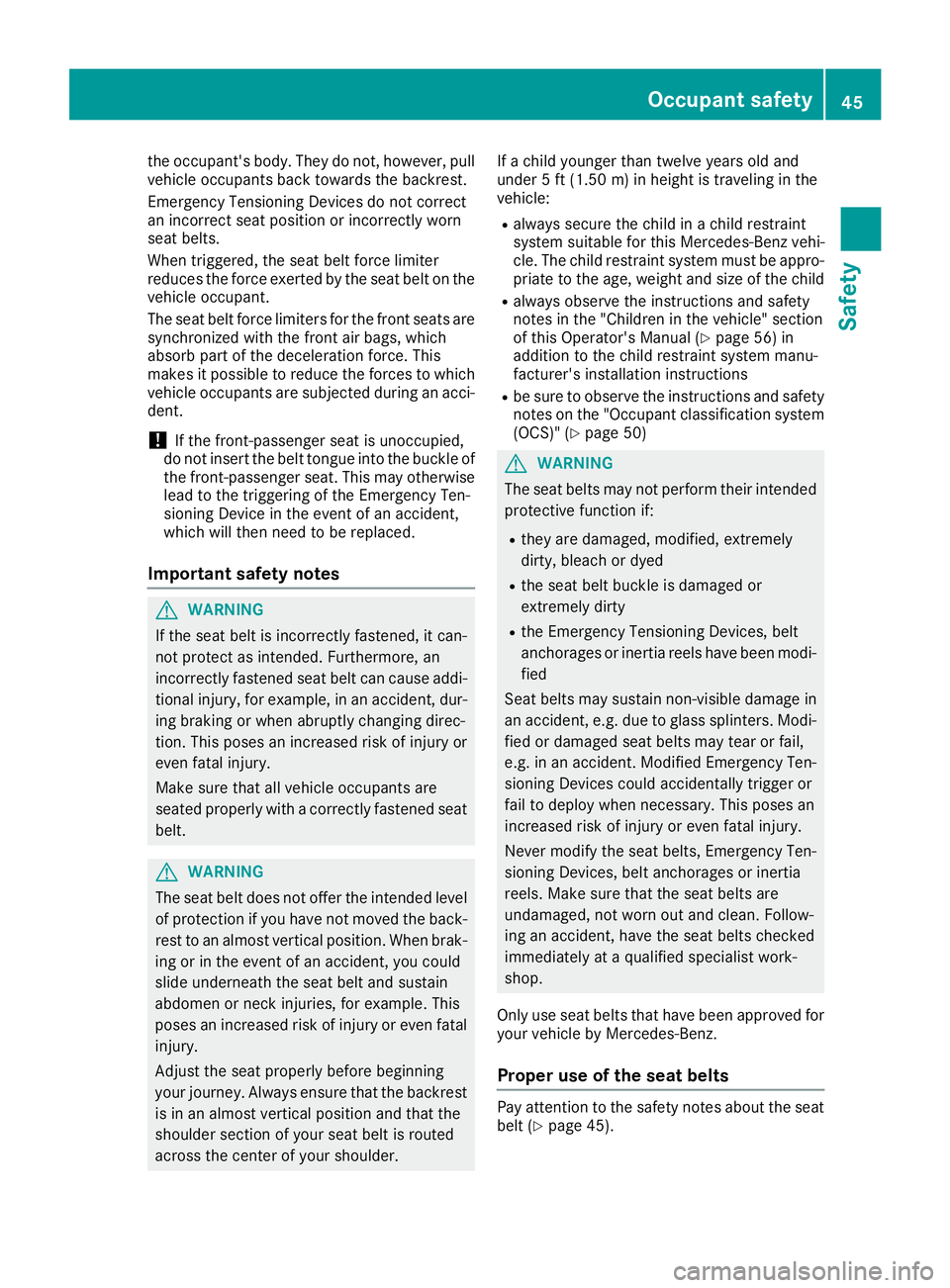
the occupant's body.The ydon ot, however, pull
vehicl eoccupants back towards the backrest.
Emergency Tensioning Devices do not correct
an incorrect seat positio norincorrectly worn
seat belts.
When triggered ,the seat belt force limiter
reduce sthe force exerted by the seat belt on the
vehicl eoccupant.
The seat belt force limiters for the front seats are
synchronize dwitht he front ai rbags, which
absor bpartoft he deceleratio nforce. This
makes it possibl etoreduce the forces to which
vehicl eoccupants ar esubjected durin ganacci-
dent.
!If the front-passenge rseatisu noccupied,
do not insert the belt tongue into the buckle of
the front-passenge rseat. Thi smayotherwise
lead to the triggerin gofthe Emergency Ten-
sioning Device in the event of an accident,
which will thenn eedtober eplaced.
Important safety notes
GWARNING
If the seat belt is incorrectly fastened ,itcan-
not protect as intended. Furthermore, an
incorrectly fastened seat belt can cause addi-
tional injury,f or example, in an accident, dur-
ing braking or when abruptl ychanging direc-
tion. Thi sposes an increasedr iskofi njury or
eve nfatal injury.
Make sure thata llvehicl eoccupants are
seate dproperly with acorrectl yfas tened seat
belt.
GWARNING
The seat belt does not offer the intende dlev el
of protection if yo uhaven ot moved the back-
res ttoana lmostvertica lposit ion. When brak-
ing or in the event of an accident, yo ucould
slid eunderneath the seat belt and sustain
abdomen or neck injuries, for example. This
posesani ncreasedr iskofi njury or eve nfatal
injury.
Adjust the seat properly befor ebeginning
your journey .Alway sensur ethatt he backrest
is in an almos tvertica lposit iona nd thatt he
shoulde rsectio nofy ours eatb eltisr outed
across the cente rofyours houlder. If
ac hild younger thant welve yearsoldand
under 5ft(1.50 m) in height is traveling in the
vehicle:
Ralways secur ethe child in achild restraint
systems uitabl efor thisM ercedes-Benz vehi-
cle .The child restraint systemm ustbea ppro-
priate to the age, weight and size of the child
Ralways observe the instructions and safety
note sint he "Children in the vehicle" section
of thisO perator' sManual(
Ypage 56 )in
additio ntothe child restraint systemm anu-
facturer' sinstallatio ninstructions
Rbe sure to observe the instructions and safety
note sont he "Occupant classification system
( O
CS) "(Ypage 50)
GWARNING
The seat belts mayn ot perform their intended
protective functio nif:
Rtheya redamaged, modified ,extremely
dirty,b leachord yed
Rthe seat belt buckle is damage dor
extremel ydirty
Rthe Emergency Tensioning Devices ,belt
anchorage sorinertia reels have been modi-
fied
Sea tbelts mays ustain non-visibl edamag ein
an accident, e.g .due to glas ssplint ers.Modi-
fie dord amaged seat belts mayt earorf ail,
e.g .inana ccident. Modified Emergency Ten-
sioning Devices could accidentall ytrigge ror
fail to deploy when necessary.T hisp oses an
increasedr iskofi njury or eve nfatal injury.
Never modify the seat belts ,Emergency Ten-
sioning Devices ,belta nchorage sorinertia
reels .Makes uret hatt he seat belts are
undamaged ,not worn ou tand clean. Follow-
ing an accident, have the seat belts checked
immediatel yataqualified specialis twork-
shop.
Onlyu seseat belts thath aveb eena pproved for
your vehicl ebyMercedes-Benz.
Proper use of the seat belts
Pa ya ttentio ntothe safety note sabout the seat
belt (Ypage 45).
Occupant safety45
Safety
Z
Page 48 of 310
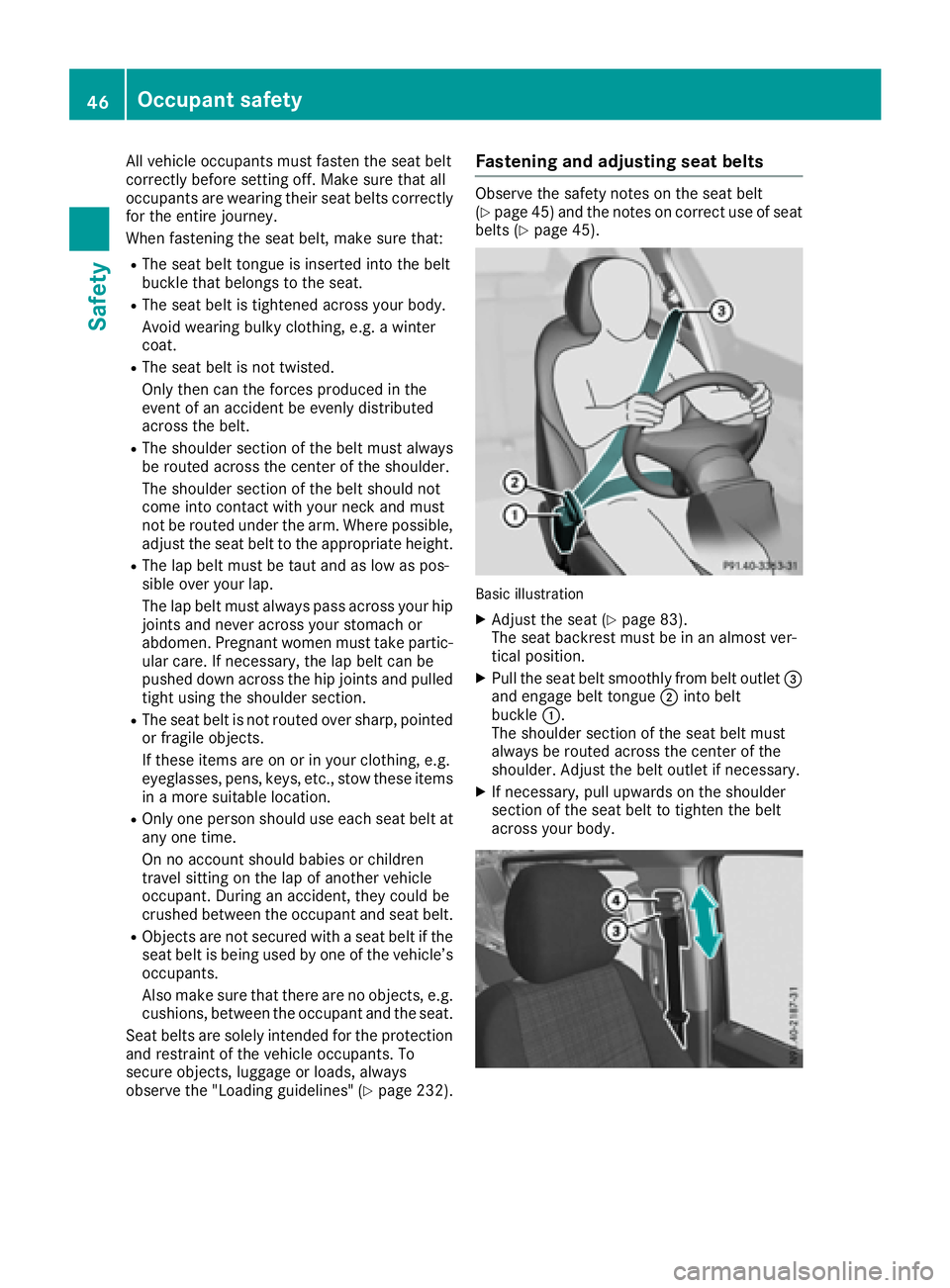
All vehicleoccupants must fasten the sea tbelt
correctl ybefore setting off. Make sure thata ll
occupants ar eweari ng thei rseatb elts correctly
for the entire journey.
Whe nfastening the sea tbelt, make sure that:
RThe sea tbeltt ongu eisinserte dinto the belt
buckle thatb elongs to the seat.
RThe sea tbeltist ightene dacross your body.
Avoi dweari ng bulky clothing, e.g .awinter
coat.
RThe sea tbeltisn ot twisted.
Onlyt hen can the forces produced in the
event of an accident be evenly distributed
across the belt.
RThe shoulde rsectio noft he belt must always
be routed across the cente rofthe shoulder.
The shoulde rsectio noft he belt shoul dnot
come into contact with your neck and must
not be routed under the arm. Where possible,
adjus tthe sea tbelttot he appropriate height.
RThe la pbeltm ustbet auta nd as lo waspos-
sibl eovery ourlap .
The la pbeltm usta lway spassa cross your hip
joints and neve racross your stomach or
abdomen. Pregnant women must take partic-
ular care. If necessary,t he lapbeltc an be
pushe ddowna cross the hipj oints and pulled
tight using the shoulde rsection.
RThe sea tbeltisn ot routed ove rsharp, pointed
or fragile objects.
If the sei te
ms ar eonoriny ourc lothing, e.g.
eyeglasses ,pen s, keys, etc., stow thes eitems
in am ore suitabl eloc ation.
ROnlyo ne persons houlduseeach sea tbelta t
any one time.
On no account shoul dbabie sorc hildren
travel sitting on the la pofanother vehicle
occupant. During an accident, they could be
crushe dbetween the occupant and sea tbelt.
RObjects ar enot secured with aseatb eltift he
sea tbeltisb eing used by one of the vehicle’s
occupants.
Als om akes uret hatt hereareno objects, e.g.
cushions, between the occupant and the seat.
Sea tbelts ar esolel yintende dfor the protection
and restraint of the vehicl eoccupants. To
secur eobjects, luggage or loads, always
observe the "Loading guidelines" (
Ypage 232).
Fastenin gand adjusting seat belts
Observ ethe safety notes on the sea tbelt
(Ypage 45) and the notes on correct us eofseat
belts (Ypage 45).
Basic illustration
XAdjust the sea t(Ypage 83).
The sea tbackres tmustbeinana lmostv er-
tica lposit ion.
XPull the sea tbelts moothl yfrom belt outlet =
and engag ebeltt ongue ;into belt
buckle :.
The shoulde rsectio noft he sea tbeltm ust
always be routed across the cente rofthe
shoulder. Adjust the belt outle tifnecessary.
XIf necessary,p ullu pwar ds on the shoulder
sectio nofthe sea tbelttot ighten the belt
across your body.
46Occupant safety
Safety
Page 49 of 310
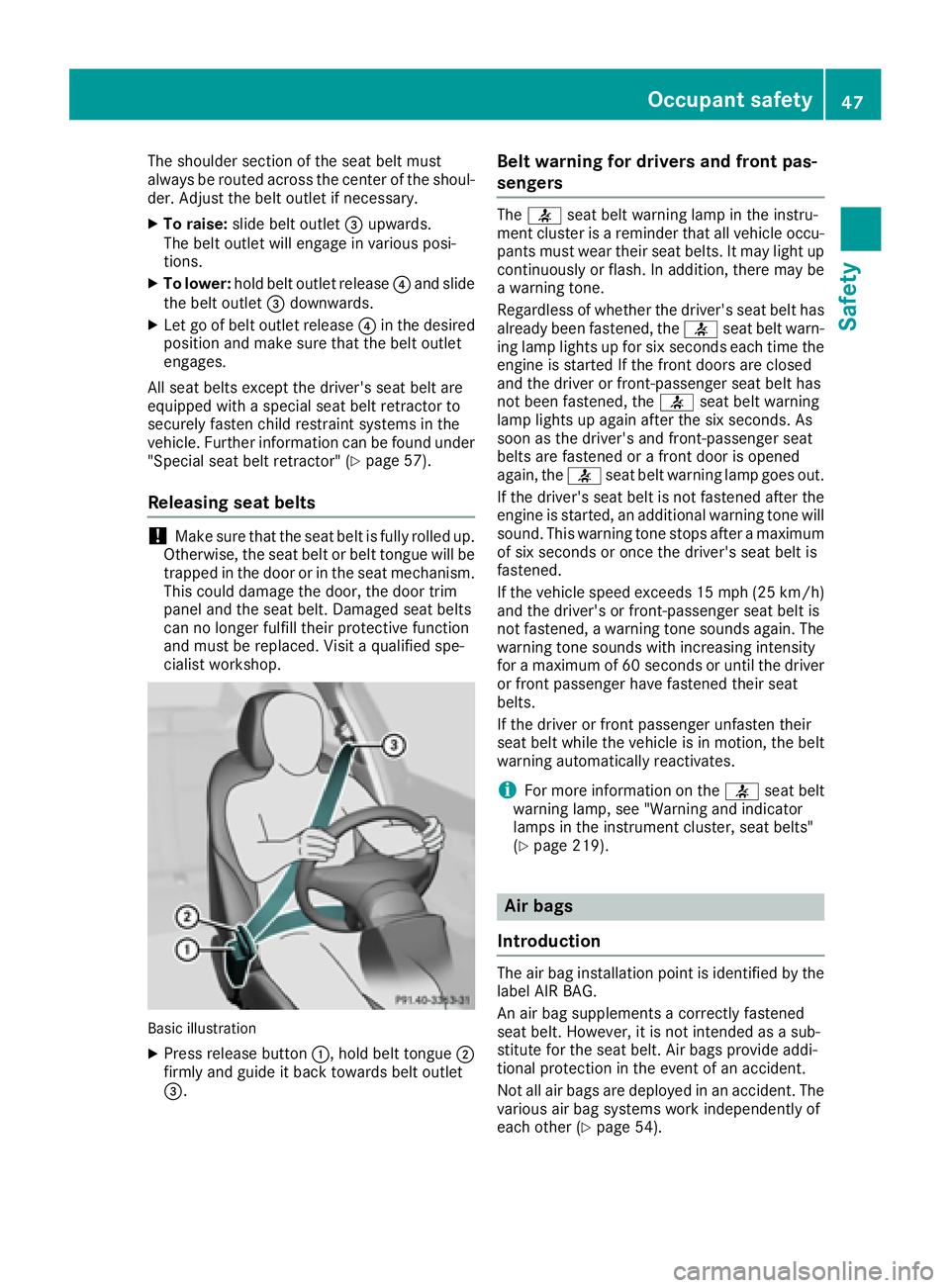
The shoulder section of the seat belt must
alwaysberouted across the center of the shoul-
der. Adjust the belt outlet if necessary.
XTo raise: slide belt outlet =upwards.
The belt outlet will engage in various posi-
tions.
XTo lower: hold belt outlet release ?and slide
the belt outlet =downwards.
XLet go of belt outlet release ?in the desired
position and make sure that the belt outlet
engages.
All seat belts except the driver's seat belt are
equipped with aspecial seat belt retractor to
securely fasten child restraint systems in the
vehicle. Further information can be found under
"Special seat belt retractor" (
Ypage 57).
Releasing seat belts
!Make sure that the seat belt is fully rolled up.
Otherwise, the seat belt or belt tongue will be
trapped in the door or in the seat mechanism.
This could damage the door, the door trim
panel and the seat belt. Damaged seat belts
can no longer fulfill their protective function
and must be replaced. Visit aqualified spe-
cialist workshop.
Basic illustration
XPress release button :,hold belt tongue ;
firmly and guide it back towards belt outlet
=.
Belt warning for driver sand front pas-
sengers
The 7 seat belt warning lamp in the instru-
ment cluster is areminder that all vehicle occu-
pants must wear their seat belts. It may light up
continuously or flash. In addition, there may be
aw arning tone.
Regardless of whether the driver's seat belt has
already been fastened, the 7seat belt warn-
ing lamp lights up for six seconds each time the engine is started If the front doors are closed
and the driver or front-passenger seat belt has
not been fastened, the 7seat belt warning
lamp lights up again after the six seconds. As
soon as the driver's and front-passenger seat
belts are fastened or afront door is opened
again, the 7seat belt warning lamp goes out.
If the driver's seat belt is not fastened after the
engine is started, an additional warning ton ewill
sound. This warning ton estops after amaximum
of six seconds or once the driver's seat belt is
fastened.
If the vehicle speed exceeds 15 mph (2 5km/ h)
and th edriver'sorf ront-passenger seat belt is
no tfastened, awarning tone sounds again.T he
warning tone sounds with increasing intensity
for am aximum of 60 seconds or until th edriver
or frontp assenger have fastene dtheir seat
belts.
If th edriver or frontp assenger unfasten their
seat belt while th evehicle is in motion,t hebelt
warning automatically reactivates.
iFor morei nformationonthe7 seat belt
warning lamp, see "Warning and indicator
lamps in th einstrumentc luster, seat belts"
(
Ypage 219).
Air bags
Introduction
The air bag installatio npointisi dentified by the
label AI RBAG.
An air bag supplements acorrectly fastened
seat belt.H owever,itisnotintended as asub-
stitut efor th eseat belt.A ir bags provide addi-
tional protection in th eeven tofana ccident.
Not all air bags are deployed in an accident. The
various air bag systems work independently of
each other (
Ypage 54).
Occupant safety47
Safety
Z
Page 50 of 310
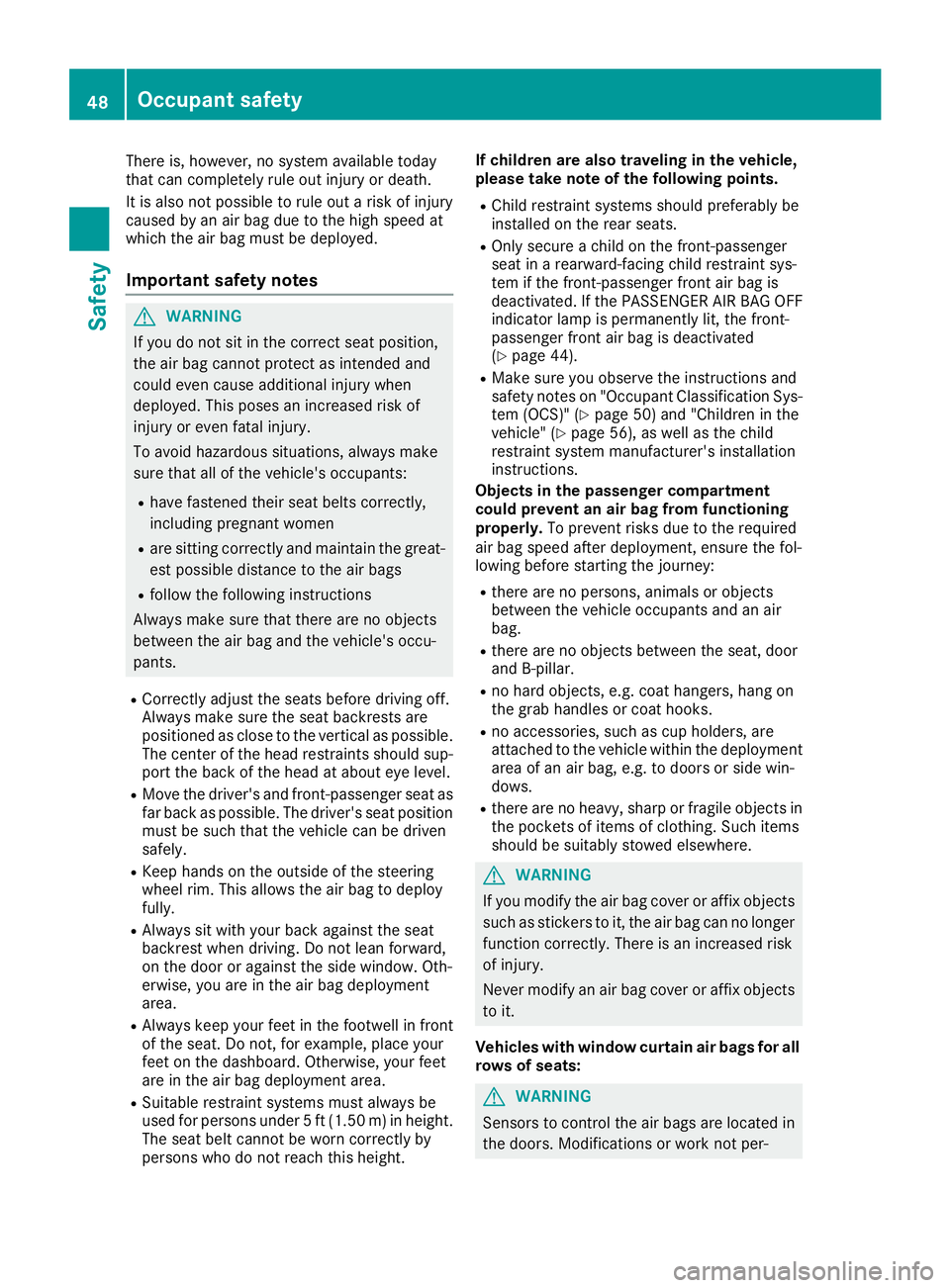
There is, however, no system availabletoday
that can completely rule out injury or death.
It is also not possible to rule out arisk of injury
caused by an air bag due to the high speed at
which the air bag must be deployed.
Important safety notes
GWARNING
If you do not sit in the corrects eat position,
the air bag cannot protec tasintended and
could even cause additional injury when
deployed. This poses an increased risk of
injury or even fatal injury.
To avoid hazardous situations, alwaysm ake
sure that all of the vehicle's occupants:
Rhave fastened their seat belts correctly,
including pregnant women
Rare sittin gcorrectly and maintain the great-
est possible distance to the air bags
Rfollow the following instructions
Always make sure that there are no objects
between the air bag and the vehicle's occu-
pants.
RCorrectly adjust the seats before driving off.
Always make sure the seat backrest sare
positioned as close to the vertical as possible.
The center of the head restraints should sup-
port the back of the head at about eye level.
RMove the driver's and front-passenger seat as
far back as possible. The driver's seat position
must be such that the vehicle can be driven
safely.
RKeep hands on the outside of the steering
wheel rim. This allows the air bag to deploy
fully.
RAlways sit with your back against the seat
backrest when driving. Do not lean forward,
on the door or against the side window. Oth-
erwise, you are in the air bag deployment
area.
RAlways keep your feet in the footwell in front
of the seat. Do not,f or example, place your
feet on the dashboard. Otherwise, your feet
are in the air bag deployment area.
RSuitable restraint systems must alwaysb e
used for persons under 5ft(1.50 m) in height.
The seat belt cannot be worn correctly by
persons who do not reach this height. If children are also traveling in the vehicle,
please take note of the followingp
oints.
RChild restraint systems should preferably be
installed on the rear seats.
ROnly secureachild on the front-passenger
seat in arearward-facing child restraint sys-
tem if the front-passenger front air bag is
deactivated. If the PASSENGER AIR BAG OFF
indicator lamp is permanently lit, the front-
passenger front air bag is deactivated
(
Ypage 44).
RMake sure you observe the instructions and
safety notes on "Occupan t Classification Sys-
tem (OCS)" (Ypage 50) and "Children in the
vehicle" (Ypage 56), as well as the child
restraint system manufacturer's installation
instructions.
Objects in the passenger compartment
could prevent an air bag from functioning
properly. To prevent risks due to the required
air bag speed after deployment, ensure the fol-
lowing before starting the journey:
Rthere are no persons, animals or objects
between the vehicle occupantsa nd an air
bag.
Rthere are no object sbetween the seat, door
and B-pillar.
Rno hard objects, e.g. coat hangers, hang on
the grab handles or coat hooks.
Rno accessories, such as cup holders, are
attached to the vehicle within the deployment
area of an air bag, e.g. to doors or side win-
dows.
Rthere are no heavy, sharp or fragile object sin
the pocketsofi tems of clothing. Such items
should be suitably stowed elsewhere.
GWARNING
If you modify the air bag cover or affix objects
such as stickers to it, the air bag can no longer
function correctly. There is an increased risk
of injury.
Never modify an air bag cover or affix objects
to it.
Vehicles with window curtain air bags for all
rows of seats:
GWARNING
Sensorstoc ontrol the air bags are located in
the doors. Modifications or work not per-
48Occupant safety
Safety